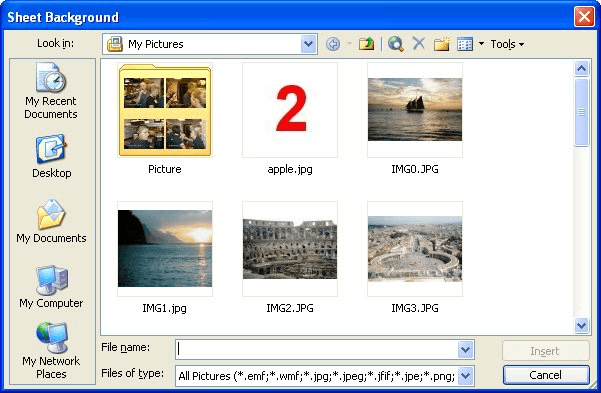Please Note: This article is written for users of the following Microsoft Excel versions: 97, 2000, 2002, and 2003. If you are using a later version (Excel 2007 or later), this tip may not work for you. For a version of this tip written specifically for later versions of Excel, click here: Changing Excel's Background Color.
Written by Allen Wyatt (last updated January 4, 2025)
This tip applies to Excel 97, 2000, 2002, and 2003
The standard background color in Excel is white. You may, at some time, want to change the background color to something else, such as a light grey. Unfortunately, there is no way to change the background color; it is not a configurable option in Excel. There are a few things you can try as workarounds, however.
One approach involves selecting all the cells in the worksheet and applying a fill color to the cells. If you don't want the color to print, then you simply need to select all the cells and remove the fill color. This could be automated by using a macro to do the color removal, printing, and re-application.
There are drawbacks to such an approach, however. First, the colors used to fill the cells could interfere with the successful application of conditional formatting, if the conditional formatting involves the use of fill colors. (Conditional formatting applied to font specifications shouldn't be a problem.)
Another option is to create, in your favorite graphics program, a small rectangle that matches the color you want used for your background. Save the small rectangle as a graphics file, using the JPG file format. Then, within Excel, follow these steps:

Figure 1. The Sheet Background dialog box.
The graphic image is placed in the background and repeated over and over again so that it fills the entire background. The benefit to this approach is that it doesn't affect any conditional formatting and the background image won't print.
Speaking of conditional formatting, if you aren't using conditional formatting for any purpose in a worksheet, you could use it to create your background. In a blank area of your workbook, define a cell that contains the value True. Then select your worksheet that you want to have the background color, and use a conditional format to define that color. The format can look at the cell you defined, and if it is True, then the color is applied. If the cell is not True, then the color is not applied. This allows you to turn the background color on or off (for printing) by changing the value of a single cell.
You could also define styles for use in your worksheet. Define a style that has the desired background color, and another that does not. You can then apply the colored style when editing and the non-colored style when preparing to print.
ExcelTips is your source for cost-effective Microsoft Excel training. This tip (3133) applies to Microsoft Excel 97, 2000, 2002, and 2003. You can find a version of this tip for the ribbon interface of Excel (Excel 2007 and later) here: Changing Excel's Background Color.

Professional Development Guidance! Four world-class developers offer start-to-finish guidance for building powerful, robust, and secure applications with Excel. The authors show how to consistently make the right design decisions and make the most of Excel's powerful features. Check out Professional Excel Development today!
FREE SERVICE: Get tips like this every week in ExcelTips, a free productivity newsletter. Enter your address and click "Subscribe."
There are currently no comments for this tip. (Be the first to leave your comment—just use the simple form above!)
Got a version of Excel that uses the menu interface (Excel 97, Excel 2000, Excel 2002, or Excel 2003)? This site is for you! If you use a later version of Excel, visit our ExcelTips site focusing on the ribbon interface.
FREE SERVICE: Get tips like this every week in ExcelTips, a free productivity newsletter. Enter your address and click "Subscribe."
Copyright © 2025 Sharon Parq Associates, Inc.
Comments